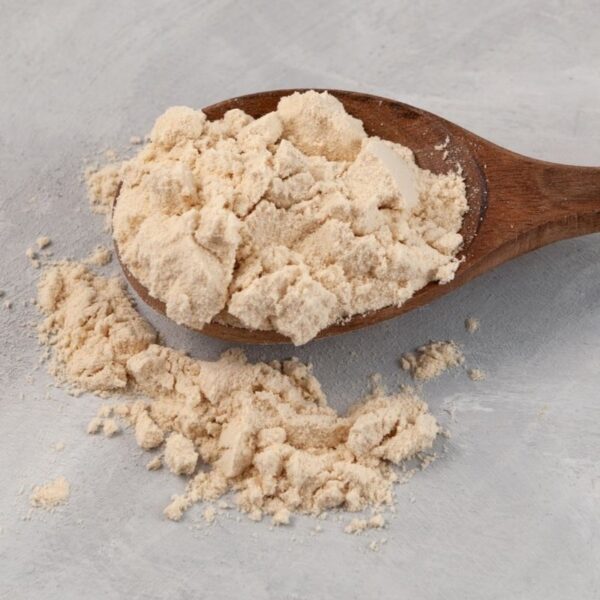Erythritol, also known as Erythoglucin, is a white crystalline powder with a clean, sweet taste similar to sucrose. It is approximately 60% as sweet as sucrose and flows easily due to its non-hygroscopic character. Like other polyols, erythritol does not promote tooth decay and is safe for people with diabetes. However, erythritol’s caloric value of zero calories per gram distinguishes it from other polyols. Erythritol is used as a flavor enhancer, humectant, nutritive sweetener, stabilizer and thickener, sequestrant, or texturizer in foods.
What is Erythritol?
Erythritol is the reduced form of either D- or L-erythrose and one of the two reduced forms of erythrulose. Its formula is C4H10O4, or HO(CH2)(CHOH)2(CH2)OH.
Source: Wikipedia
How is Erythritol Produced?
Erythritol is naturally present in small amounts in some fruits, including grapes, pears, and melons, and in higher amounts in others, including watermelon, raspberry, and strawberry.
Some fermented foods, such as cheese, wine, and soy sauce, may contain small amounts of erythritol. Certain types of mushrooms, such as shiitake and reishi mushrooms, contain small amounts of erythritol.
The erythritol content of several natural and processed foods is listed in the following table.
| Food | Erythritol Content |
| Watermelon | 22 mg/kg |
| Melon | 47 mg/kg |
| Pear | 0-40 mg/kg |
| Grape | 0-42 mg/kg |
| Soy Sauce | 910 mg/L |
| Miso Bean Paste | 1,310 mg/kg |
| Sherry Wine | 70 mg/L |
| Wine | 130-300 mg/L |
| Sake | 1,550 mg/L |
Source: ResearchGate
For commercial purposes, erythritol is produced via fermentation by yeast and yeast-like fungi, utilizing substrates such as glucose, fructose, xylose, sucrose, cellulose, and glycerol. Fermentation is a cost-effective method for large-scale erythritol production.
There are two primary methods of fermentation production:
- Via fermentation by yeast and yeast-like fungi via the pentose phosphate pathway.
- Via lactic acid bacteria from glucose via the phosphoketolase pathway.
Following fermentation, the broth is heated and filtered to remove microorganisms and other impurities before it is dried into crystals. Erythritol yields can be increased by optimizing the fermentation parameters and/or gene-targeting biotechnologies.
Applications in the Food Industry
| Function | Role |
| Bulking Agent | Adds volume to food products without significantly adding calories |
| Emulsifier | Helps to stabilize mixtures of two immiscible liquids, such as oil and water |
| Stabilizer | Helps to prevent unwanted changes in the texture or consistency of food products over time |
| Thickener & Texturizer | Helps to thicken the consistency of food products |
| Humectant | Helps retain moisture in food products |
Product Examples
| Type | Examples |
| Bakery | Cake, Pastry, Cookies, Bread |
| Confectionery | Chewing Gums, Soft Chews, Gummy Bears, Crystal Candies |
| Dairy | Yogurt, Ice Cream |
| Beverages | Juices, Soft Drinks |
| Convenience | Jams, Jellies, Cereals, Fruit Preserves |
In addition to the food products listed above, erythritol finds applications in special diets, as follows:L
- Weight Management: Due to its low caloric value, erythritol reduces the caloric load of food, helping manage weight by overall calorie reduction.
- Diabetes Management: Erythritol does not cause a spike in blood glucose levels. For this reason, it is an ideal sweetener for the diabetic population.
- Keto Diet: Erythritol provides sweetness without acting as a carbohydrate or refined sugar. It can be used in keto diets.
Properties of Erythritol
| Molecular Weight | 122 |
| Melting Point | 122℃ |
| Heat of Solution | -180 J/g |
| Physical Form | Powder, crystals (granules), syrup |
| Solubility (25 ℃) | 47 g/100g sater |
| Viscosity (1% w/v, 25 ℃) | 1.3 cP |
| Calorific Value | 0.2 Cal/g |
| Relative Sweetness w.r.t Sucrose | 60-70% |
| Glycemic Index | ~0 |
| Shelf Life | 24-36 months |
| GMO Status | GMO/ Non-GMO |
| Claims *Subject to product claims | Kosher, Halal, Dairy-free, Sugar-free, Non-cariogenic, Plant-based*, Organic*, Non-GMO*, Natural*, Allergen-free* |
| Storage Requirements | Cool, dry, dark place <40℃) |
| Specific Rotation | No optical rotation |
Typical Formulations
Ice cream
Here is a formulation table for ice cream formulated with erythritol with the % composition of ingredients.
| Ingredient | % Composition |
| Whole milk | 64.5 |
| Milk cream | 10.5 |
| Skim milk powder | 4.5 |
| Emulsifiers and stabilizers | 0.5 |
| Erythritol | 20.0 |
Using erythritol in the formulation above instead of sucrose achieves a calorie reduction of 23%, with a decrease in the melting rate and an increase in firmness.
Source: Elsevier
Chewing Gum
Here is a formulation table for chewing gum formulated with erythritol with the % composition of ingredients.
| Ingredient | Composition % |
| Gum base | 19.2 |
| Corn syrup | 6.0 |
| Dextrose | 10.0 |
| Lactose | 5.0 |
| Glycerin | 8.9 |
| Flavor | 0.9 |
| Erythritol | 50.0 |
Source: Google Patents
Danish Cookies
Here is a formulation table for cookies formulated with erythritol with the weight composition of ingredients.
| Ingredient | Composition (wt.) |
| Bread flour | 300.0 |
| Butter | 135.0 |
| Shortening | 75.0 |
| Powdered sugar | 67.5 |
| Erythritol | 67.5 |
| Sodium chloride | 3.0 |
| Whole egg | 75.0 |
| Milk | 30.0 |
Source: Wiley
Erythritol Formulation Considerations
Stability
Erythritol has excellent pH and heat stability in food processing. The latent heat of erythritol under air decreases with the increasing temperature of thermal treatment. In a study, erythritol was chemically stable after being heated above its melting temperature and up to 141°C. Mixtures of erythritol with antioxidants had a lower degradation rate compared to pure erythritol under air. Browning was observed along the heating treatment of mainly pure erythritol. Antioxidants were found to help to reduce erythritol degradation.
Sensory Properties
| Physical Form | Powder, crystals, syrup |
| Color | White |
| Taste | Fresh, sweet taste (similar to sucrose), with no lingering aftertaste or off-taste. Masks the off-taste of other ingredients and sweeteners. The taste threshold is 23.0-44.7 mM. |
| Odor | Odorless |
Erythritol has a strong cooling effect (endothermic or positive heat of solution) when it dissolves in water, often compared with mint flavors’ cooling effect. The cooling effect is present only when erythritol is not dissolved in water, which might be experienced in an erythritol-sweetened frosting, chocolate bar, chewing gum, or hard candy. The cooling effect of erythritol is similar to that of xylitol and has among the most potent cooling effects of all sugar alcohols.
Use as a Sugar Substitute
Erythritol can be used as a sugar substitute to replace sugar fully or partially in food formulations. There are several benefits to using erythritol as a sugar substitute:
- The low caloric value of erythritol (0.2 Cal/g) makes it an efficient alternative to sugar for total caloric reduction of foods without altering the sweet taste.
- Erythritol has a bulk density similar to sucrose, so that it can be used as a bulk sweetener.
- Erythritol does not affect serum glucose levels or significantly affect serum levels of total cholesterol, triacylglycerol, free fatty acids, Na, K, or Cl.
The following table compares the properties of erythritol with other sugar alcohols:
| Sugar Alcohol | Calorific Value (kcal/g) | Relative Sweetness (to Sucrose) | Glycemic Index |
| Maltitol | 2.1 Cal/g | 80-90% | ~35 |
| Erythritol | 0.2 Cal/g | 60-70% | ~0 |
| Xylitol | 2.4 Cal/g | 80-100% | ~13 |
| Sorbitol | 2.6 Cal/g | 50-60% | ~9 |
| Mannitol | 1.6 Cal/g | 50-60% | ~2 |
A detailed comparison of all sugar alcohols can be seen here.
While erythritol is an excellent sugar substitute, it has several limitations that should be considered:
- The relative sweetness of erythritol compared to sucrose is 60-70%. The dosage of erythritol has to be higher when used solely to obtain the desired sweetness level.
- Erythritol occurs naturally in fruits and vegetables but in very minute quantities. This makes natural extraction not commercially viable.
- The high cost of erythritol can be a significant concern while formulating food products with budget constraints.
Synergistic Activity
Erythritol can be efficiently combined with other sugar alcohols in various formulations to obtain the desired effect. It synergizes with high-intensity non-nutritive sweeteners (sucralose, aspartame, and aceK) to provide the desired sweetness. The functional properties of erythritol and the higher sweetness of non-nutritive sweeteners create an ideal combination.
Erythritol can mask certain unwanted aftertastes, such as astringency, and reduce the irritant effect of intense sweeteners, including saccharin, aspartame, acesulfame potassium, sucralose, stevia, and thaumatin.
Metabolism, Absorption, and Excretion
- Absorption: Erythritol is rapidly absorbed by up to 90% of the gastrointestinal tract. The remaining 10% of the erythritol dose enters the colon.
- Metabolism: The erythritol dosage taken by the gastrointestinal tract is not metabolized. The gut microbiota ferments the portion entering the colon.
- Excretion: The erythritol dosage taken by the gastrointestinal tract is excreted unchanged via urine. The portion in the gut unchanged by microbes is excreted via stool. Chronic intake of erythritol over seven days showed that 78% of ingested erythritol was excreted in the urine.
Effect on Properties of Food Products
| Freezing Point Depression | The small molecular size of erythritol gives it a high freezing point depression factor. For example, ice cream formulated with erythritol must be chilled to lower temperatures to achieve the desired texture.Erythritol has a much stronger tendency to crystallize after freezing, which hardens the texture significantly during initial storage. |
| Shelf-Life Extension | In a study, using erythritol improved mechanical properties and shelf life, producing a smoothing effect on the macaron surfaces and significantly affecting their color coordinates. |
| Emulsification | In a study, adding erythritol to whey protein isolate improved emulsification and emulsion stability. Erythritol induced interactions between hydrophobized protein particles. In another study, erythritol improved the emulsion stability of an oil-in-water emulsion. |
| Water Holding Capacity & Wettability | In a study, erythritol improved curdlan gel’s water-holding capacity and freeze-thaw stability. Erythritol has better wettability than normally encountered in bulking agents. |
Safety and Regulatory Considerations
| FDA Information | The FDA permits using sugar alcohols, another class of sweeteners, as sugar substitutes. Erythritol has been determined to be GRAS through scientific procedures per 21 CFR § 170.30(a) and (b). |
| EU Information | In the EU, erythritol can be used as a food additive with number E 968. |
Safety & Toxicity of Erythritol
- Higher consumption of sugar alcohols can lead to bloating and an upset stomach. Some individuals note a laxative effect. However, sugar alcohols have been deemed safe at levels associated with good manufacturing practices.
- Erythritol is mainly absorbed before it reaches the colon and excreted unchanged in the urine. Consequently, erythritol is better tolerated and is associated with fewer gastrointestinal side effects than sorbitol and xylitol at comparable doses.
- Higher blood levels of the artificial sweetener erythritol have been associated with an increased risk of heart attack and stroke.
Identification Numbers
| IUPAC Name | (2S,3R)-butane-1,2,3,4-tetrol |
| CAS Number | 149-32-6 |
| EC Number | 205-737-3 |
| INS No. (Food Additive) | INS 968 |
| E Number (Food Additive) | E 968 |
Acceptable Limits or Maximum Usage
- FDA: The estimated daily intake (EDI) per user of all intended uses of erythritol at that time was previously calculated by the FDA to be 13 g/day at the mean and 30 g/day at the 90th percentile. The estimated daily per kilogram body weight intake of erythritol from individual proposed food uses as per the NHANES data has been given here.
- WHO JECFA: The ADI for erythritol is not specified by the WHO JECFA.
- National Library of Medicine: A study showed that the tolerable upper limits for erythritol are higher than for other polyols (0.66 gm/kg/day in men and 0.80 gm/kg/day in women). However, larger doses (1 gm/kg/day) were reported to be well-tolerated as per clinical studies.
- EU: The EU allows using erythritol (E 968) as a flavor enhancer in energy-reduced or with no added sugars flavored drinks up to 16000 mg/kg.
Fun Facts About Erythritol
- Erythritol can be used in baking but does not caramelize or brown like sugar. Therefore, it may not work well in recipes that rely on sugar browning for flavor and texture.
- Erythritol does not promote tooth decay and is considered tooth-friendly. Some chewing gums and candies use erythritol to reduce the risk of cavities.
Additional Resources
- Erythritol: an interpretive summary of biochemical, metabolic, toxicological and clinical data
- Erythritol: An In-Depth Discussion of Its Potential to Be a Beneficial Dietary Component
- Optimization of sweetener formulation in sugar-free yoghurt using response surface methodology
- Effect of Erythritol on Quality Characteristics of Reduced-Calorie Danish Cookies
- Erythritol combined with non-nutritive sucralose increases feeding by Drosophila suzukii, quickens mortality and reduces oviposition










